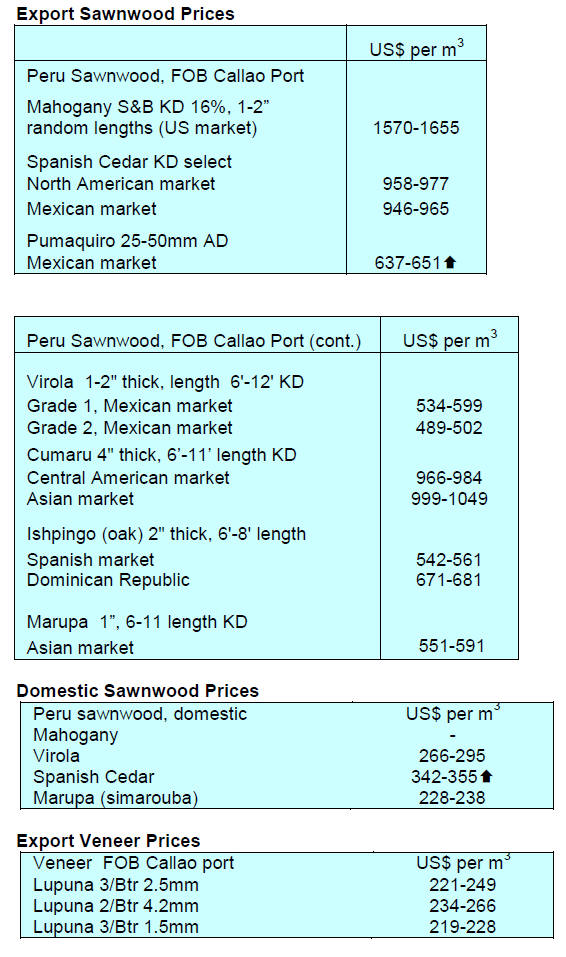3.
MALAYSIA
MTIB support for Bumiputera entrants
to furniture manufacturing sector
According to Mohd. Kheiruddin, Malaysian Timber Industry Board (MTIB)
Director General, Malaysia exported RM12.5 billion’s worth of wood products
between January and July this year. In 2018, the timber industry contributed
1.6% to the Gross Domestic Product and the export value of timber products
recorded a 4% decline to RM22.29 billion, compared to RM23.22 billion in
2017.
In related news, Mohd. Kheiruddin said the government remains committed to
encourage more participation of Bumiputera companies in the furniture
industry explaining that MTIB manages the Bumiputera Furniture Entrepreneur
Scheme and provides training and guidance for new entrants to the sector
through the Wood Industry Skills Development Centre.
MTCC Conference - certification as a driver for innovation
Over 200 participants including some from Singapore and Indonesia joined a
dialogue on certification as a driver for disruptive innovation and the
future of certification in a digital economy as part of an MTCC conference
to celebrate its 20th anniversary.
Themed “Pushing Boundaries Advancing Sustainability”, the one-day conference
addressed development and progress of timber certification in Malaysia as
well as looking to the future of certification beyond 2030.
The conference provided a platform for industry and the MTCC to discuss how
Malaysia’s certification scheme and processes could remain credible,
effective and efficient in delivering market access.
The first shipment of 732 cu.m of MTCS-certified sawnwood was exported to
the Netherlands in July 2002.
For more see:
https://mtcc.com.my/mtcc-organises-conference-to-bridge-present-and-future-outlook-for-certification-beyond-2030/
In related certification news, the Malaysian Palm Oil Board has said estates
of more than 40 hectares with palm oil mills that fail to obtain the
Malaysian Sustainable Palm Oil (MSPO) certification or begin the process of
certification before 1 January 2020, will be penalised under the Malaysian
Palm Oil Board (Licensing) 2005 regulation number 15. The MSPO certification
will be mandatory from 1 January.
Bamboo plantations - time to explore new sources of commodity income
The Malaysian Government intends to provide soft loans to encourage the
bamboo plantation sector. Teresa Kok, Minister of Primary Industries, said
the loan could be up to RM10,000 per hectare with repayments to begin after
seven years.
Currently the Malaysian government provides loans
under the Forest Farm Development Programme but these are primarily for
rubber plantations. The Minister said the time has come for Malaysia to
explore additional sources of commodity income so should seize on the
growing opportunities in the international bamboo trade.
4.
INDONESIA
Attracting investment
in Indonesia’s furniture manufacturing
A delegation, led by the Chairman of the Investment Coordinating Board
(BKPM), Thomas Lembong, travelled to China in an effort to boost investments
from China in Indonesia’s furniture manufacturing sector.
Indonesia has recognised that China’s furniture exports, at over US$20
billion a year, dwarf Indonesia’s exports which are less than 10% of that.
This business promotion exercise has been well prepared and involved
discussions on incentives that could be offered to Chinese companies that
wish to invest in Indonesia.
See:
https://www.tubasmedia.com/ri-tawarkan-insentif-fiskal-untuk-relokasi-industri-mebel-china/#.XZIMXfkzbIU
Expanding market share in the US furniture market
Abdul Sobur, Chairman of the Indonesian Furniture and Crafts Industry
Association (HIMKI), has said his Association is teaming up with the
Indonesian Furniture Designers Association (HDMI) in an effort to develop
furniture designs to suit the requirements of individual markets.
Through this approach, said Sobour, it will be possible for local companies
to expand market share in the main importing countries in particular the US.
The association has an export target of US$1.8 billion for this year with
around a third being exports to the US.
See:
https://ekonomi.bisnis.com/read/20191001/257/1154043/indonesia-siap-ambil-pangsa-mebel-china-di-as
Environmental Fund Management Agency established
In a joint statement the Coordinating Ministry for Economic Affairs, the
Ministry of Environment and Forestry (KLHK) and the Ministry of Finance
officially launched the Environmental Fund Management Agency (BPDLH) within
the Ministry of Finance.
The Minister of Environment and Forestry, Siti Nurbaya, said the BPDLH will
be one of the financing mechanisms for environmental protection and
management that can be utilised by various parties.
BPDLH will secure and distribute funds for environmental protection. BPDLH
funding will be sourced from public and private sources both domestic and
foreign said the Minister. Disbursements by the Fund will focus on small
grant, green investment projects and capacity building for communities and
also for officials.

5.
MYANMAR
Multi Stakeholder Group still
active but no apparent engagement with EU
Analysts in Myanmar are not clear on the current status of the VPA/FLEGT
negotiations between Myanmar and the EU as the UK Department for
International Development (DFID) suspended its financial support for the
negotiations about one year ago.
Some commentators have said that Myanmar is no longer considered a VPA
country but the EU VPA website says “Currently, Myanmar is in a preparation
phase. The purpose of this phase is to prepare and establish strong
foundations for a successful negotiation should Myanmar and the EU decide to
negotiate a VPA.” While the Myanmar Multi Stakeholder Group (MSG) is still
active there is no apparent engagement with the EU.
It has been learnt that recently an assessor from NepCon, a non-profit
organisation that builds commitment and capacity for mainstreaming
sustainability, recently visited Myanmar to assess the timber legality
framework in the country and spent time with the MSG, the Forest Department,
the Myanma Timber Enterprise and the Myanmar Forest Certification Committee
(MFCC).
Barber Cho, Secretary of the MFCC, confirmed the visit explaining this was
planned with Palladium, DiFID and the European Timber Trade Federation
(ETTF) before DiFID suspended support for Myanmar’s VPA negotiation process.
Palladium is an international advisory and management business and was the
fourth-largest private sector partner for the UK Government's Department for
International Development (DFID).
The NepCon assessor focused on Myanmar’s ‘CoC Dossier’ and the Myanmar
Timber legality Assessment System (MTLAS) and Cho said the authorities in
Myanmar were completely frank and transparent with the assessor.
Manufacturers applaud investment plans for energy sector
The energy sector has been allocated a massive amount of funds in the Budget
for fiscal 2019-20, which commenced October 1. This is the first time the
energy sector has attracted the highest portion of government spending. The
energy sector has been under funded for years causing in hydropower and
other power generation projects.
Electricity prices have been raised in Myanmar and the government will
benefit and can therefore invest more in power supplies which will encourage
investment in manufacturing.
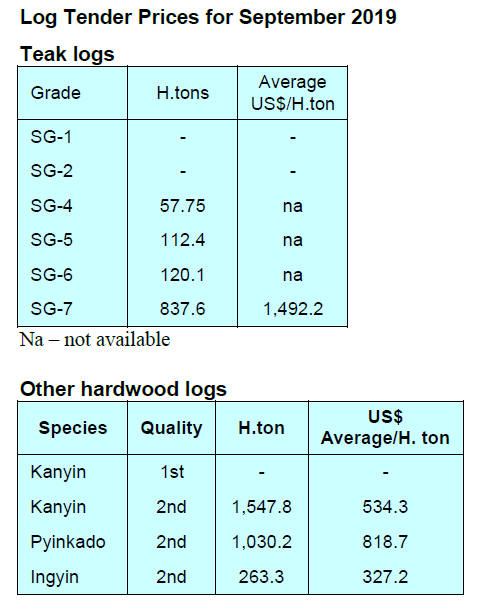
6. INDIA
Manufacturing could get boost from
rate cut
India’s GDP growth dropped to a six-year low of 5% in the second quarter and
according to the Reserve Bank of India (RBI) the economy is likely to face
more risks in the near term from a combination of domestic and global
issues.
Over the past few months domestic manufacturers have experienced subdued
demand which prompted a cut back in production, efforts to reduce
inventories and fewer purchases from suppliers. This say analysts was partly
why the RBI to cut interest rates in early October. The October cut was the
fifth cut in 2019 and it had an immediate impact on the rupee/dollar
exchange rate which dipped below 71 to the US dollar.
The quarter percent cut in rates is aimed at kick-starting the economy
lifting it from its six-year low. Borrowing rates have been lowered to 5.15%
which should help boost the housing market.
However, a CREDIA spokesperson recently commented that the government’s
US$1.4 billion fund to finance stalled housing projects is unlikely to
succeed as the sector is facing its worst crisis in decades because consumer
and business confidence are at a low level.
See: //economictimes.indiatimes.com/articleshow/71132591.cmsutm_source=contentofinterest&utm_medium=text&utm_campaign=cppst
Procedures for export of red sanders
A recent Indian government announcement sets a timeline for red sanders
producing States to finalise the procedures for the export of this valuable
timber.
See:
https://dgft.gov.in/policies/notifications
The text reads as follows:
Subject: Export of Red Sanders wood by Directorate of Revenue Intelligence
{DRI), State Governments of Andhra Pradesh, Maharashtra, Tamil Nadu and
Karnataka - Extension of time regarding.
1. In exercise of powers conferred by Section 3 of the Foreign Trade
(Development & Regulation) Act,1992 read with Para 1.02 of the Foreign Trade
Policy (2015-2020), the Central Government hereby makes the amendments in
Notification No. 47 (RE-2013)/2009-2014 dated 24.10.2013 read with
Notification No. 6/2015-2020 dated 06.05.2015, Notification No. 24/2015-2020
dated 29.08.2016, Notification No. 25/2015-2020 dated 02.09.2016,
Notification No. 40/2015-20 dated 27.11.2017, Notification No. 08/2015-20
dated 23.05.2017 and Notification No. 48/2015-20 dated 03.01.2019.
2. Directorate of Revenue Intelligence (DRI) and State Governments of Andhra
Pradesh, Maharashtra, Tamil Nadu and Karnataka shall finalize the modalities
including allocation of quantities to various entities, as applicable, for
export of the balance quantity of Red Sanders wood and shall complete the
whole process of export latest by 31st December, 2019.
3. Other provisions of Notification No. 47 (RE-2013)/2009-2014 dated
24.10.2013 read with Notification No. 24/2015-2020 dated 29.08.2016 (for
Andhra Pradesh and DRI), Notification No. 25/2015-2020 dated 02.09.2016 (
for Tamil Nadu and Maharashtra) and Notification No. 40/2015-20 dated
27.11.2017 (for Karnataka) shall remain unchanged.
See also:
https://dgft.gov.in/sites/default/files/Noti%2012%20dt%2029.07.2019%20Eng_0.pdf
Imported plantation teak
The Goods and Services Tax Committee at its last meeting did not consider
the requests from the timber sector for a reduction in GST rates for raw
material inputs to the industry. Manufacturers continue to push for a
downward revision of the 18% GST on wood products.
C&F prices for imported teak at Indian ports from various other sources
continue within the same range as given earlier.
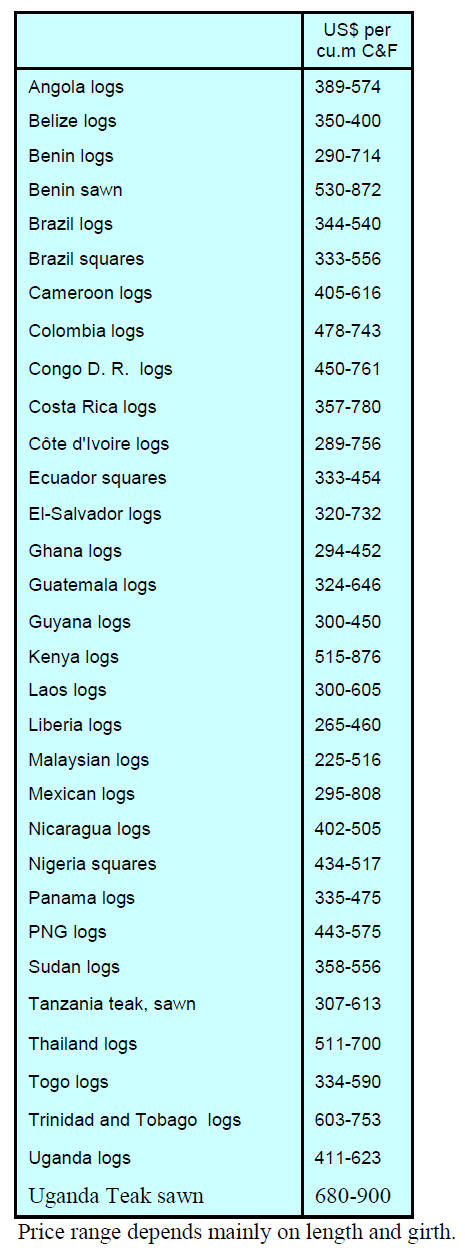
Locally sawn hardwood prices
Prices have been maintained as reported last time. Demand and imports are
stable.
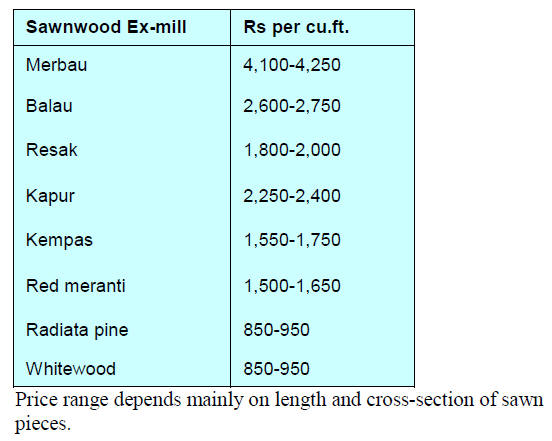
Myanmar teak prices
With due care necessary to maintain revenue, GST council has not been able
to offer any relief. Markets have accepted the situation. The general
conditions are improving and loans and credit facilities are started afresh
and hope demand will improve.
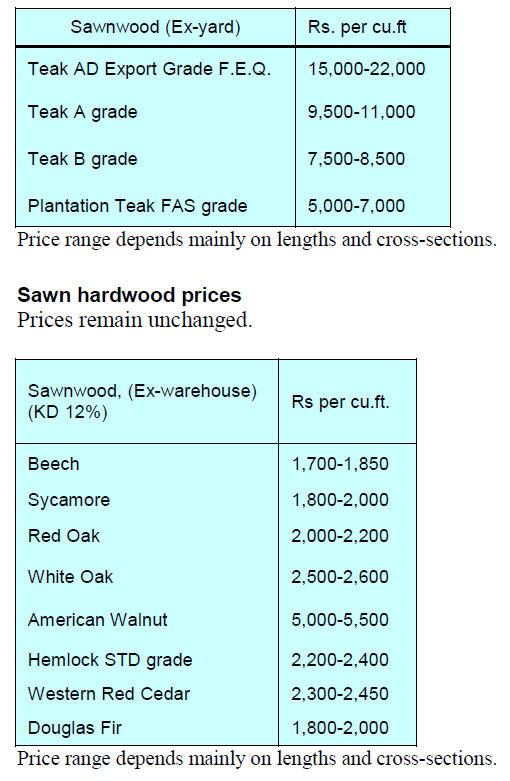
Plywood
The ex-warehouse prices have not been raised and continue as previously
reported. Manufactures complain that there is now a shortage of good quality
peeler logs and that recovery rates are suffering. The diminishing
availability of the traditional peeler log species has encouraged millers to
turn to other species which are more readily available.
The presence of Chinese made plywood is growing in the Indian market as
Chinese manufacturers seek alternative markets to the US to avoid high US
tariffs.
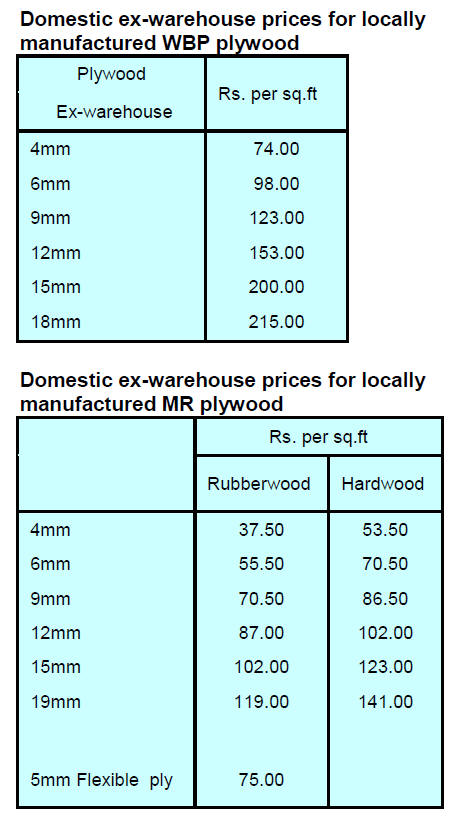
7.
VIETNAM
Surge in foreign investment
from China
The surge in the number of new FDI projects into Vietnam’s wood processing
sector continues. Most of the investment is in woodchip production,
processing industry services, wooden pallet production and composite panel
products.
Xuan Phuc,(Forest Trends) has reported that most of the incoming investment
is from China. In the first 5 months of 2019 there was a total investment of
over US$50 million from China, 1.7 times the amount in the same period in
2018.
Tran Quoc Khanh, Deputy Minister, in the Ministry of Industry and Trade has
called for a registration system so the ministry can track investment and
exports in critical sectors such as panel products as there is a need to
effectively manage the export supply chain. This he said would aid Customs
in eliminating fake labelling and prevent fraud.
Vietnam’s exports of wood products to the US are around about US$3-4 billion
annually and Vietnam is the second largest supplier to the US after China
.In the first 7 months of 2019, China’s market share of the US furniture
market fell sharply while Vietnam gained market share. Tran Quoc Khanh said
this is an opportunity for Vietnamese firms to fill the gap in US imports
but will require companies to address their productivity, marketing and
procurement policies.
Dien Quang Hiep, Chairman of Binh Duong Wood Processing Association (BIFA)
has pointed out that one of the biggest drawbacks at present is that there
are no production clusters and networks among Vietnamese companies which is
allowing new entrants in the sector to gain an advantage.
In related news, Le Trieu Dung, Director of the Chamber of Commerce and
Industry, said that it is necessary for the authorities to be on the lookout
for signs of fake relabeling of exports especially in the plywood sector.
In 2018 and the first 6 months of 2019, the Vietnam Chamber of Commerce and
Industry (VCCI), in conjunction with the Customs Department, Vietnam Chamber
of Commerce and Industry (VCCI), inspected a number of the Vietnam based
enterprises from which there was a sudden and sharp increase in export
volumes.
The survey was intended to uncover fake export labelling. The US Customs
service also had a team in Vietnam to investigate the sudden rise in wood
product exports seemingly originating in Vietnam which raised suspicions of
cross-border trade between Vietnam and China for re-export.
See:
https://nongnghiep.vn/khuyen-khich-phat-trien-trong-rung-go-lon-post250769.html
https://saigondautu.com.vn/kinh-te/ngan-chan-gian-lan-thuong-mai-trong-xuat-khau-go-72903.html
Concerns raised over raw material availability
Concerns have been raise over the rapid increase in wood chip production and
export which, say analysts, could threaten raw material availability for the
domestic solid wood processing industry. In response the authorities in
Quang Nam Province are seeking the development of technical standards for
forest management and harvesting for chip plantations.
In Quang Nam Province there are about 200,000 ha of plantations, mainly
acacia. Most of this area is of small scale household plots and harvesting
is done when the trees are around 3-4 years old. The harvested timber is
chipped and shipped to China from Dung Quat Port.
Currently Quang Nam harvests about 1 million tonnes of acacia annually.
There are 16 chip processing plants in the Province but there are fears that
the local supply will soon be insufficient and that the chip mills will turn
to neighboring provinces such as Da Nang and Quang Ngai. Analysts point out
that local raw material suppliers could be vulnerable should China introduce
restrictions on imports.
There are more than 100 major wood processing plants In Binh Dinh and they
are exporting to over 80 countries and territories. The wood processing
sector contributes a lot to provincial development but companies are finding
it a problem to secure raw materials.
Every year local manufacturers import more than 200,000 cu.m of wood raw
materials of which sawnwood accounts for around 85% with the balance being
logs and composite panels.
According to the Department of Industry and Trade, in the first 9 months of
this year, the Province's wood furniture manufacturing industry index rose
by nearly 7% year on year and the index for ‘other’ wood products jumped
around 27%. In the same period furniture exports reached over US$340
million, up 20% over the same period last year and accounting for 51% of the
total exports of the province.
Mr. Le Minh Thien, Chairman of Binh Dinh Timber and Forest Products
Association, said “despite the high export growth rates, the production of
export wood processing enterprises in the province faced many difficulties
in raw materials supplies. The local producers and exporters had to import
more than 80% of raw wood materials with many risks about legality and
origins”.
He pointed out that under these circumstances it is very challenging to
manage production costs and maintain competitiveness in the global market.
In responding to these comments Ngo Van Tong, Director of Department of
Industry and Trade, said there are plans develop large scale timber
plantations forests in the province by 2025 to meet 50% of raw wood
materials demand for the province's wood processing industry. Investments in
plantations would continue until they are contributing around 80% of the raw
material requirements of factories in the province.
8. BRAZIL
Results of ABIMCI forestry sector study
announced
The Brazilian Association of Mechanically-Processed Timber Industry (ABIMCI)
launched its ‘Sectoral Study 2019’ which addresses national forestry issues
and provides profiles of the timber and furniture industry including
socioeconomic indicators, market statistics such as production, consumption,
export and import data. The final report provides crucial information for
planning and promotion of sectoral development.
This study highlights the importance of planted forests in Brazil which, in
2018, extended over an estimated 8.1 million hectares with 73% eucalyptus
(5.92 million ha.), 20% pine (1.59 million ha.) and 7% with other timber
species (591,000 ha.). Out of the 591,000 ha. rubber tree accounts for 39%,
acacia (27%), paricá (15%) and teak (15%).
Hardwood species such as paricá, teak and poplar are traditionally used in
the production of sawnwood and veneer. Other timber species that have been
planted include African mahogany (Khaya senegalensis) and Australian cedar (Toona
ciliata).
In Brazil, sawnwood and plywood from native hardwoods is produced mainly in
the northern and central western regions of the Amazon. According to the
ABIMCI study, production and consumption of Amazon hardwoods has declined in
recent years.
Over the past decade production of hardwood sawnwood fell by almost 13%
annually in the period 2009-2018. In 2018, Brazil produced 2.4 million cu.m
of hardwood sawnwood, while in 2009 it produced 8.4 million cu.m.
Brazilian production of hardwood plywood has also fallen. In 2018, Brazil
produced 249,000 cu.m of hardwood plywood from Amazon species while in 2009
national production was around 587,000 cu.m (an almost 60% decline in 10
years).
The decline in production is due, says the ABIMCI report, to environmental
controls and bureaucratic hurdles in the approval process for forest
harvesting and management permits.
Trends in hardwood plywood and sawnwood exports
According to the ABIMCI study, in 2018 Brazilian exports of hardwood
sawnwood totaled about 556,000 cu.m and earned US$222 million. This was the
highest level of hardwood sawnwood exports for the last 8 years.
However, between 2009 and 2018, Brazilian export volumes of hardwood
sawnwood fell by 2.5% and the value of exports dropped almost 14% in the
same period.
Over the same period there was a decline in the value and volume of hardwood
plywood exports. In 2009 exports amounted to 97,000 cu.m (US$54 million) but
in 2018 this dropped to 61,000 cu.m (US$ 30 million).
Bento Gonçalves exports continue to increase
Export earnings by the Bento Gonçalves' furniture cluster rose 13% between
January and August this year compared to the same period of 2018. This
performance surpassed the results of the furniture industry of the state of
Rio Grande do Sul and Brazil as a whole.
According to the Ministry of Economy/Foreign Trade Secretariat (SECEX),
local companies exported US$29 million in the first eight months of 2019.
The main buyers of furniture manufactured in the Bento Gonçalves furniture
cluster were Uruguay, followed by the United States, Saudi Arabia, Chile,
Colombia, Mexico, Panama, Paraguay and Peru. It is noteworthy that the US
went from the 4th main buyer to 2nd place, and the United Kingdom, which was
not even among the top 10 destinations, now ranks 6th.
The Bento Gonçalves furniture cluster increased its exports by 13% compared
to a growth of only 2.5% in Rio Grande do Sul State exports.
The Bento Gonçalves Furniture Industry Union (Sindmóveis) estimates that
furniture exports will increase in the coming months.
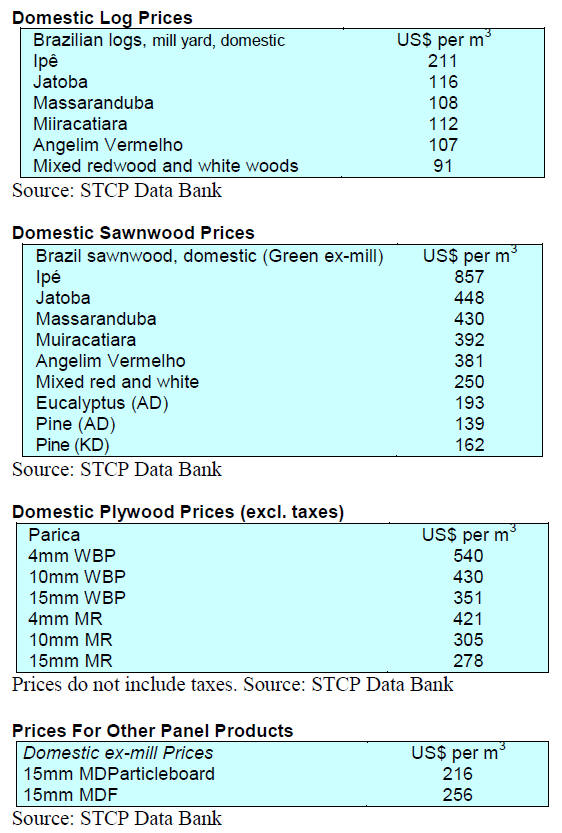

9. PERU
Amazon business congress
Business and government representatives from the Amazon Regions recently
participated in the first business congress which was inaugurated by the
President of the Republic, Martín Vizcarra Cornejo. The President was
accompanied by the Ministers of Foreign Affairs and Transportation and
Communications; Gustavo Meza-Cuadra and Edmer Trujillo.
The President confirmed his government’s commitment to the Amazon and the
Governor of Ucayali, Francisco Pezo Torres, said that the Amazon represents
60% of the Peruvian territory and through applying Sustainable Development
Goals (SDGs) has great potential. The event sought to identify the economic
and social contributions that development of the Amazon could bring.
Businessman Samuel Dyer of the Pro Ucayali group said that the full
potential of the Amazon can be released if there is a private/public
alliance. Entrepreneurs want to invest, he said, but putting in place
supportive infrastructure must be a priority.
Dyer reminded participants that there is an estimated 10 million hectares of
deforested land in Peru’s amazon and this offers an opportunity for
investment in reforestation. Dyer suggested half of this area could be
reforested with an investment of around US$25 billion. To achieve this, he
said, would require that the rapid completion of a National Competitiveness
Plan.
Regional governments move forward in Amazon zoning
With technical assistance from the National Forest and Wildlife Service
(SERFOR) the Amazon regional governments of San Martín, Ucayali, Loreto,
Amazonas, Junín, Madre de Dios and Huánuco are moving forward with the
process of forest zoning.
This was reported by the Executive Director of the SERFOR, Alberto Gonzales-Zúñiga
Guzmán, who said that forest zoning will open the potential and identify the
limitations for the direct or indirect use of forest and other natural
resources.
Ucayali, with 3 million hectares of its territory categorised has advanced
in forest zoning. The areas define protection and conservation zones; land
reserves for indigenous peoples in isolation or initial contact and
prioritised ecosystems for biodiversity conservation.
The zoning plan for Loreto could be approved this year as progress has been
good helped by the transfer of funds from the central government.
Strengthen supervision of cedar marketing
Next year, the implementation of action to strengthen the control of the
marketing of cedar will begin in support of the conclusions of the
Eighteenth Meeting of the Conference of the Parties to the Convention on
International Trade in Endangered Species of Wild Fauna and Flora (CITES) in
respect of trade in cedar. Peru has ten species of cedar and of those four
are endemic.
The Deputy Minister of Strategic Development of Natural Resources, Gabriel
Quijandría, stressed the importance of informing the public, private and
specialist on the latest decisions taken by CITES.
Timber concessions study in the final stage
A study on the operation of the timber forest concession model from the
social, economic sustainability and legal perspectives is expected to
provide a means for development of new sustainable concession management
systems for Peru.
This study is being led by SERFOR and is already in the final stage of
development. It is being undertaken with the technical support of the USAID
FOREST Program and the United States Forest Service (USFS) along with a
Peruvian NGO.
Information has been collected dating back 15 years on the forest
concessions in Loreto, Ucayali and Madre de Dios. This will reveal what has
happened in the past and how to improve the ecological sustainability of the
forest in the future. The study and recommendations will be presented at the
end of this October.
Re-allocation of non performing forest concessions
Inactive forest concessions in Ucayali and Loreto allocated more than 15
years ago are being brought into operation because the regional forestry and
wildlife authorities have introduced a legal device termed the ‘Abbreviated
Procedure’. This procedure allows cancellation of a concession agreement and
re-allocation to a new concessionaire.
Through this procedure more than half a million hectares of none performing
concession agreements have been reallocated in Ucayali and Loreto. Some of
the concession areas have suffered illegal logging and encroachment.
In September the Regional Government of Loreto approved 13 forestry
companies as qualifying to take advantage of 63 timber forest concessions
which will be valid for 40 years.
In Ucayali, last month the Regional Government launched the Abbreviated
Procedure for the granting of 26 concessions.
Currently, the authorities in Loreto are evaluating applications in
accordance with the Guidelines for granting forest concessions for timber
purposes by the Abbreviated Procedure published by SERFOR.
It is estimated that over 600,000 hectares of production forests in Ucayali
and Loreto will be brought into production.
